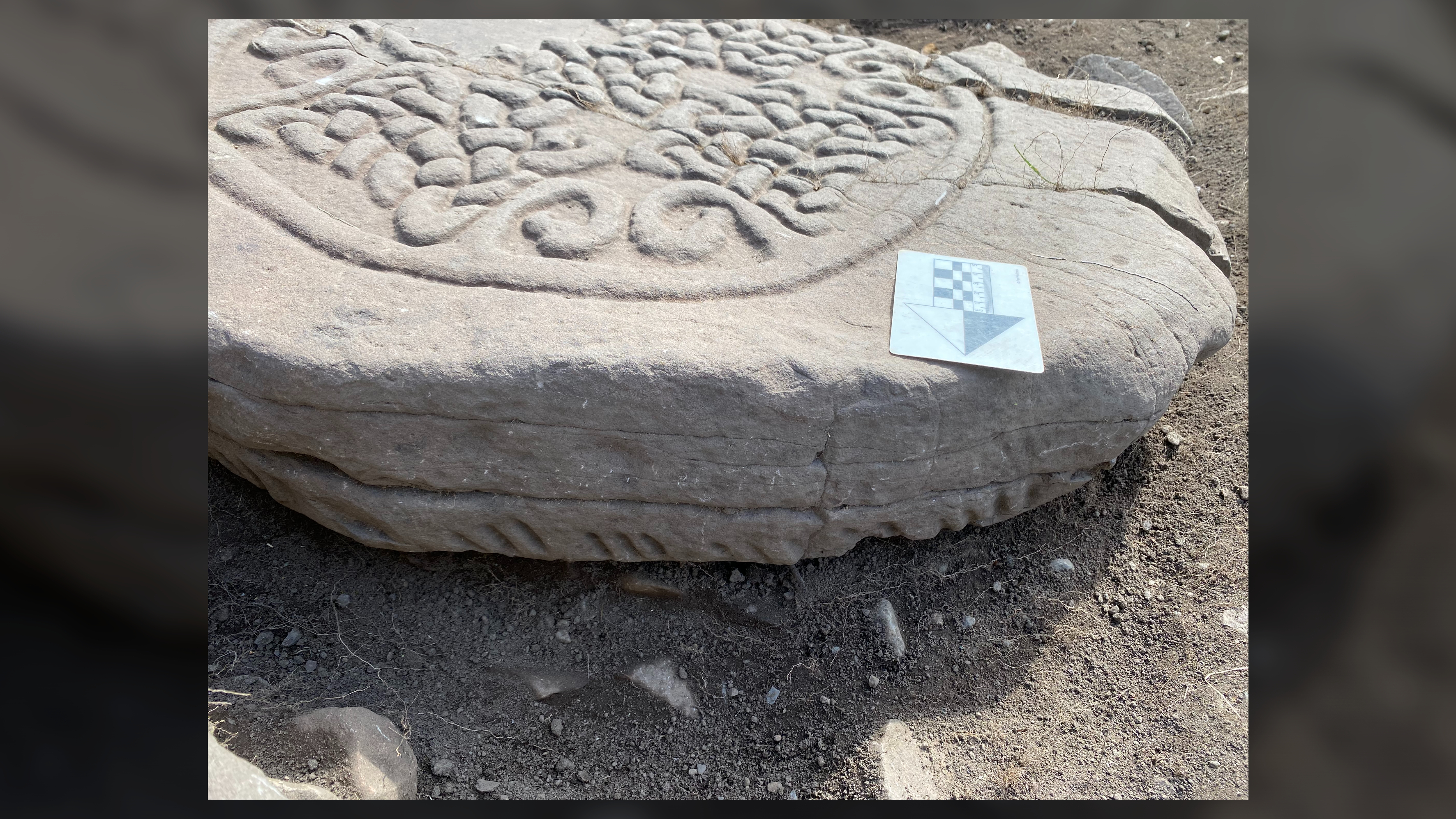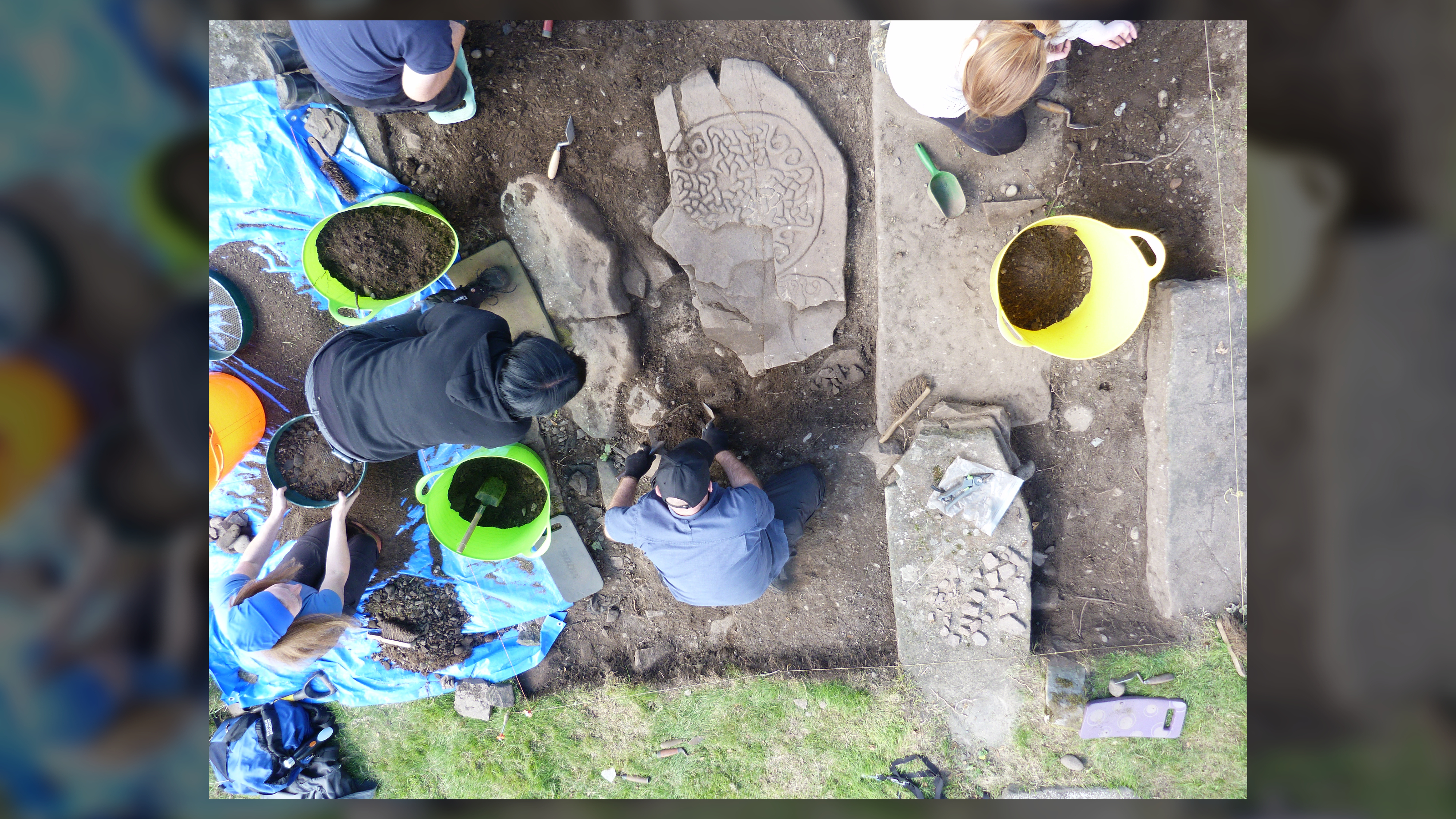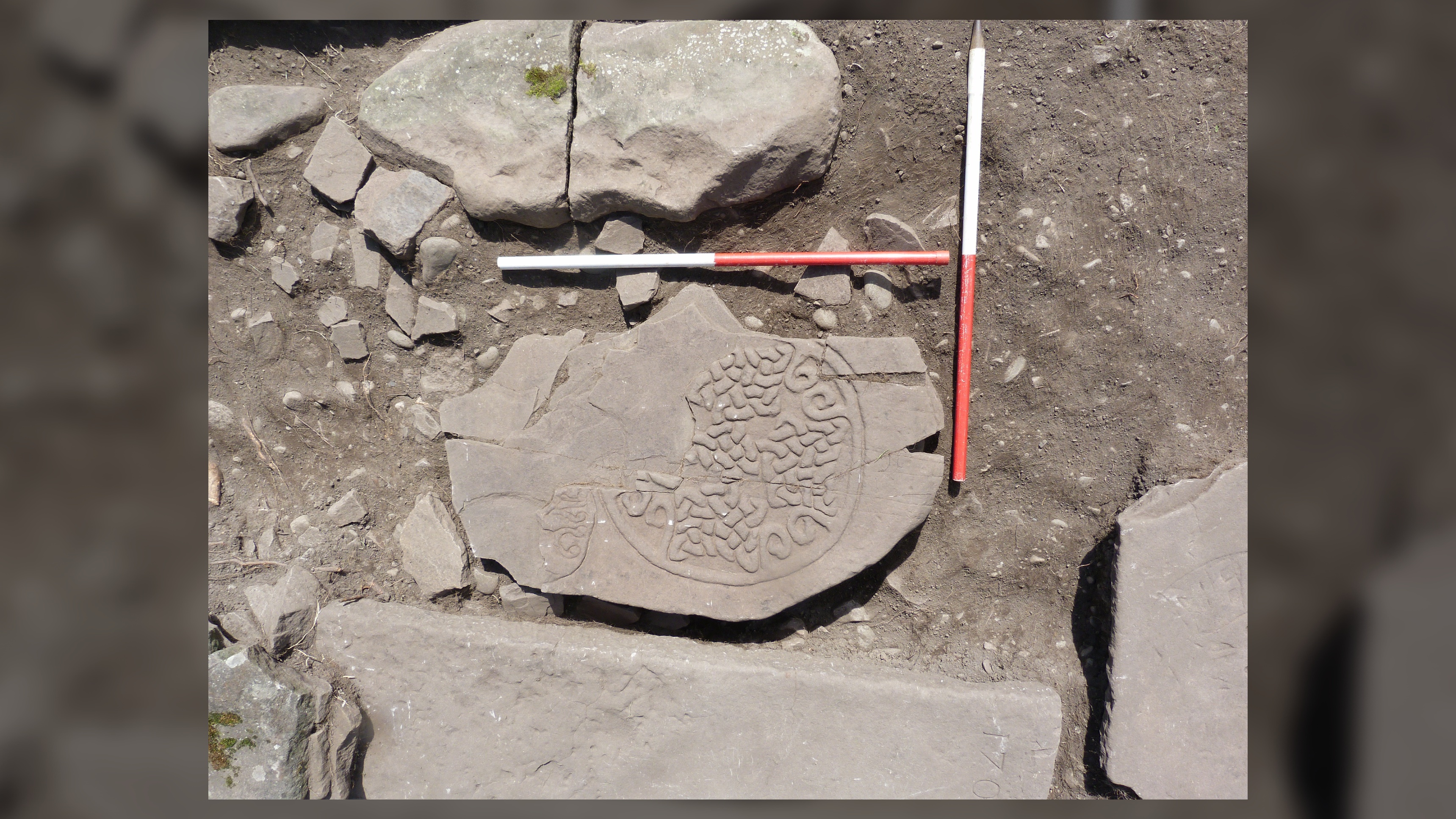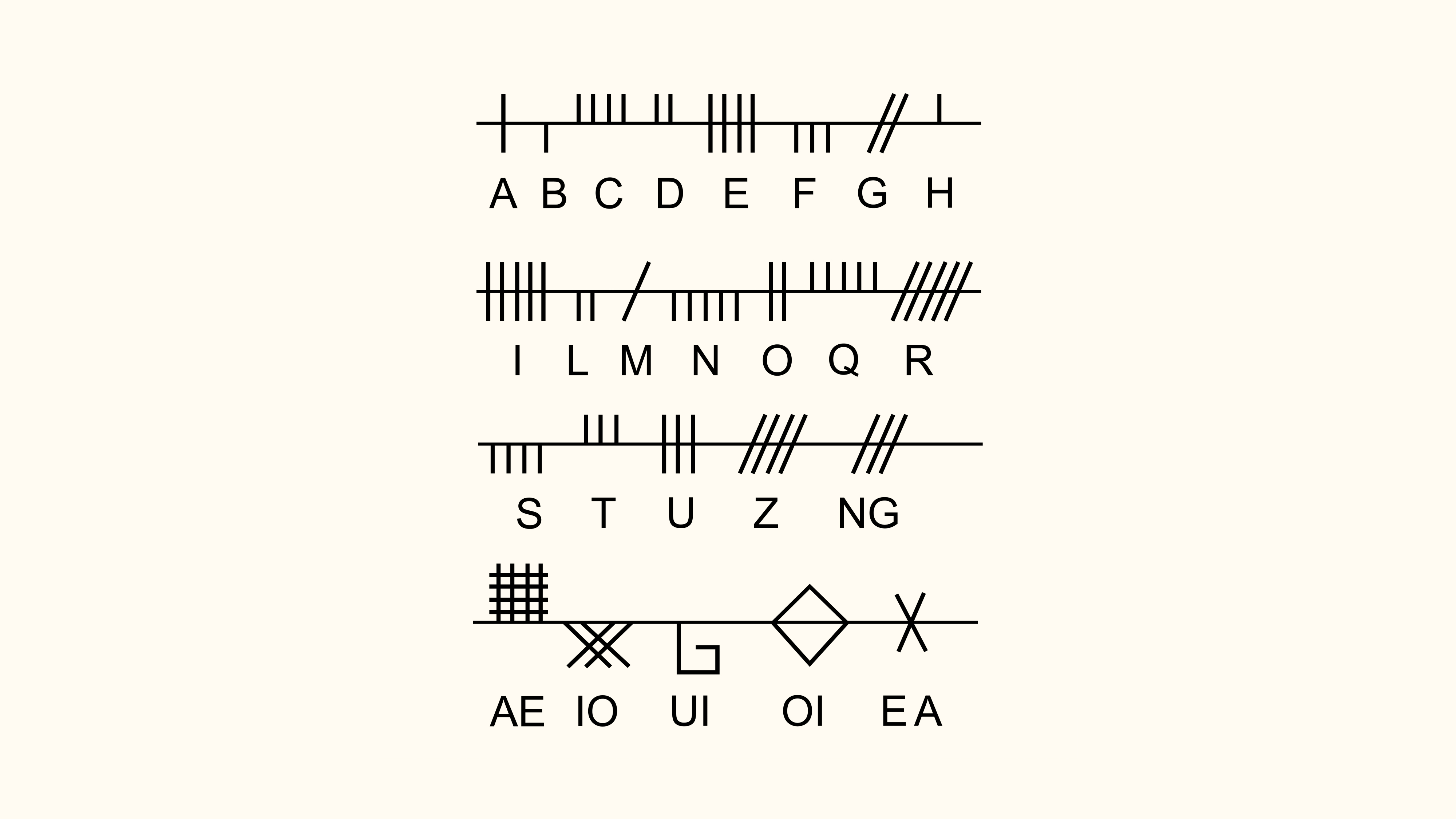Rare medieval script discovered on stone carved by Scotland's 'Painted People'
1,500-year-old carved stone from the 'Painted People' in Scotland possibly reveals a bull, pelicans and an ancient alphabet.

Archaeologists and volunteers have discovered a stone bearing a mysterious inscription and carved birds that the Picts of Scotland crafted more than a millennium ago. The cross slab, found in a small cemetery last month, dates to between A.D. 500 and 700, and sheds new light on the historic interaction between heritage and faith in the northern U.K.
The Picts, or "Painted People," were so-named by Roman historians because of their supposed war paint and tattoos ("picti," is the Latin word for "paint"). They lived in northern and eastern Scotland in the early medieval period. Likely descended from Celtic tribes, the Picts are famous for successfully resisting Roman conquest. While the Romans painted the Picts as barbarous and backward, they were largely subsistence farmers, growing grain and herding domesticated animals.
After the Roman Empire withdrew from the British Isles in the fifth century A.D., Pictish society grew to form a permanent but unstable monarchy intent on protecting its territorial boundaries. Early missionaries from Ireland converted many kings of Pictland to Christianity in the mid-sixth century A.D. Then, at the Battle of Dun Nechtain in A.D. 685, the Picts pushed the Britons out of Scotland and created a mini-empire that would last until around A.D. 900 and the arrival of the Vikings.
Related: Unknown symbols written by the lost 'painted people' of Scotland unearthed


But the newly uncovered cross slab, found in the Old Kilmadock cemetery near Doune, Scotland, a region that was historically a buffer zone between the Picts and the Romans, and later the Britons, complicates that tidy history. "The cross slab is the first one in this region, and may mean that the residents started to think of themselves as Picts," Stirling Council archaeologist Murray Cook, who led the recent excavation, told Live Science in an email.
Carved stones from early medieval Scotland are relatively common, but the newly discovered one from the Old Kilmadock cemetery, which has yet to be fully excavated, has three intriguing features: a rounded top, animal figural decorations and an inscription written in a medieval alphabet called ogham.
At 47 inches (119 centimeters) high and 32 inches (82 cm) wide, the Old Kilmadock stone is similar in size and shape to a large grave marker. Experts, however, think that they may have served multiple functions.
Sign up for the Live Science daily newsletter now
Get the world’s most fascinating discoveries delivered straight to your inbox.
Kelly Kilpatrick, a historian and Celticist at the University of Glasgow, told Live Science in an email that cross slabs "could be grave markers, and used to communicate Christian messages to a lay audience through imagery. Sometimes you find iconography from native Pictish religion intermixed with Christian iconography on these types of monuments." But its rounded top and circular, knotted cross make the Old Kilmadock stone a rare type of Pictish cross slab.
"The tips of the scrolls end with bird heads; they might be pelicans, as there is a tradition of the pelican biting its own flesh to feed to its young, echoing Christ and the Last Supper, which becomes the Eucharist," Cook explained. Below that, there is a Pictish style carved four-legged animal that looks like a bull. "The bull might be a symbol of a family, a region, or a god," Cook said.

An ogham inscription running around the side of the stone has astounded researchers. Ogham was used to write an early version of the Irish language, and it was formed by making parallel strokes and slashes along a central line. About 400 of these inscriptions have survived to the present day, mostly in Ireland, but the one from Old Kilmadock is the first to be found in central Scotland.
Kelly Kilpatrick, who will be translating the inscription, said that "it is not possible to read the ogham inscription until the stone is lifted, because ogham is written on the edge of the stone and the letters can extend to either side of this." Ogham inscriptions in general tend to spell out names of wealthy or powerful people, however.
"The cross from Old Kilmadock is a huge new find," Adrián Maldonado, a research fellow at National Museums Scotland who was not involved in the discovery, told Live Science. "The most important part of the discovery is the ogham inscription; when it is fully revealed, it can tell us more about the language spoken by those in power in this area, and potentially add a new, unrecorded name in a time with very few historical sources."
Cook suggests that the cross slab was originally used as "a public statue erected by a wealthy patron to celebrate both their Pictish heritage and their Christian faith. The ogham reflects the influence of Irish Christians." Findings in other parts of the Old Kilmadock cemetery support that interpretation: Three additional inscribed stones have been found in two different alphabets. "I think this means they were a literate and intelligent religious community," Cook said; there was "probably a monastery."
The Pictish cross slab likely survived because it was reused in much later times as a grave covering in the Old Kilmadock cemetery. Cook and Kilpatrick plan to further study the cross slab once it is fully excavated and its pieces put back together. In collaboration with the local Rescuers of Old Kilmadock group, they are currently raising funds for this analysis, which will cost thousands of dollars.
"This discovery shows the value of archaeological investigation of early church sites in Scotland," Maldonado concluded, "too few of which have been excavated. It is a huge win for community-led research, providing value both for local heritage and internationally."

Kristina Killgrove is a staff writer at Live Science with a focus on archaeology and paleoanthropology news. Her articles have also appeared in venues such as Forbes, Smithsonian, and Mental Floss. Killgrove holds postgraduate degrees in anthropology and classical archaeology and was formerly a university professor and researcher. She has received awards from the Society for American Archaeology and the American Anthropological Association for her science writing.









